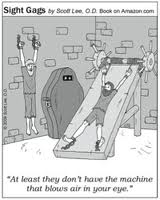Remember the puff?
Just about everyone who has had an eye exam is familiar with the “puff of air test”. It measures pressure within the eye using a puff of air, which can be startling. People who dread this test will be happy to know that we have replaced it with a new device; our modern Tono-pen is a handheld device, slightly larger than a pen. This small piece of equipment only requires one eye drop for a quick and painless measurement of eye pressure. The test aides in screening for glaucoma.

Glaucoma is a group of eye disorders that cause damage to the optic nerve, leading to progressive, irreversible vision loss if left untreated. Glaucoma is also the second leading cause of blindness in the U.S. according to the American Optometric Association. The main signs associated with glaucoma are side vision loss, high eye pressures, and optic nerve damage.
High eye pressure is the most common sign, but can be affected by changes in heart rate and blood pressure. Unfortunately, feelings of nervousness or anxiousness when sitting in front of the “puff of air” machine can cause eye pressure readings higher than normal. This is why it is so important to have a device that can get readings quickly and easily. The Tono-pen does just that; more accurate measurements are taken over time to determine if your eye pressure is increasing and potentially causing glaucoma. For more information on glaucoma please visit glaucoma.org or the American Optometric Association.
Blog contribution by Joseph Gray , Optometry Intern, College of Optometry ,Western University of Health Sciences






